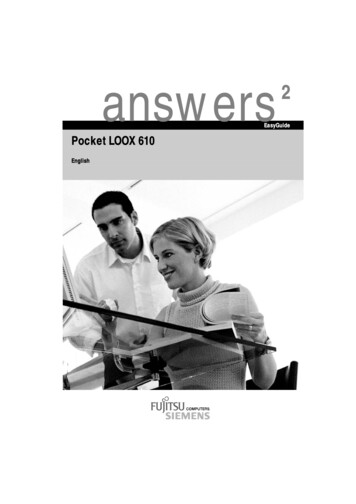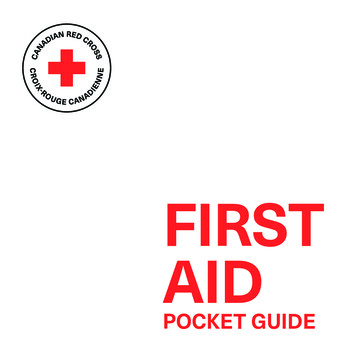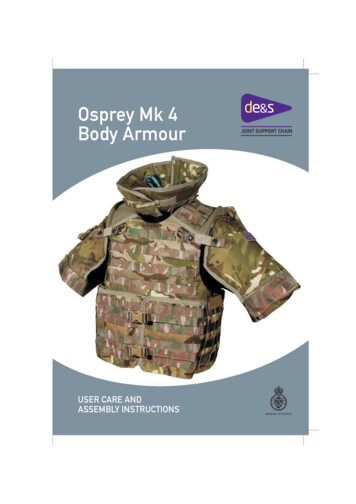
Transcription
A pocket guide toMotivationalInterviewing
Developing competency in Motivational Interviewing(MI) takes practice. The best way to learn MI is withpractice with feedback. This tool will not replacethat!Have someone competent in MI observe a session(or recorded session with permission) and give youfeedback on their observations.What this guide will do is help you after trainingplan and review sessions using MI.What is Motivational Interviewing?Motivational Interviewing is a collaborative, goalorientated style of communication with particularattention to the language of change. It is designed tostrengthen personal motivation for and commitmentto a specific goal by eliciting and exploring theperson’s own reasons for change within anatmosphere of acceptance and compassion.(Miller and Rollnick 2013)The essence of MI is that it is the client rather thanthe worker who makes the argument for change. Itis not a collection of techniques but a way to guideconversation to activate a person’s own motivationand resources for change.The way in which you talk with peoplecan substantially influence their personalmotivation for behaviour change.
Deep roots and a strong trunk helpsproduce fruit you are working toward‘OARS’Listen till e Spirit of MIPartnershipAcceptanceCompassionEvokingPrinciples (RULE)Avoid the righting reflexUnderstandListenEmpowerThere is something in human nature that resistsbeing coerced and told what to do. Ironically, it isacknowledging their freedom to choose and not changethat sometimes makes change possible.What will you do to stay consistent with thespirit and principals of MI?
The core skills of MIO:Open questions: to explore concerns,promote collaboration, and understand theclient’s perspective.A:Affirmations: to support strengths, conveyrespect.R:Reflective listening: to explore deeper,convey understanding, deflect discord, elicitchange talk.S:Summarise: to organise discussion, clarifymotivation, provide contrast, focus thesession and highlight change talk.Reflect with each question if possible:Encouraging the other person toelaborate, amplify, confirm, or correct. A Simple Reflection may use differentwords but stays at the same meaning A complex reflection makes a guessabout what the person means.It adds something that deepensunderstanding and encouragesfurther exploration.
Use variety in your reflections:-Sounds like What I’m hearing is So you’re saying that You’re feeling like For you, it’s a matter of .From your point of view, You are I would imagine you Must be Through your eyes, Your belief is that Your concern is that It seems to you that You’re not terribly excited about You’re not much concerned about The thing that bothers you is The important thing as you see it is You can get as much from reflections, evenmore than relying on questions.Your clients will teach you how effective yourreflections are. They keep talking.
The processes of MIEngaging PlanningAllow time to develop atrusting relationshipListen, understand, AvoidtrapsEvokingFocusingEngaging- How comfortable isthis person in talking to me?- Do I understand this person’s perspective/concerns?Focusing Help client to prioritise areas of change.- An agenda map helps support focusing.- What goals for change does this personreally have?- Do I have a clear sense of where we aregoing?- Do I have different aspirations for changefor this person?- Does this feel more like dancing orwrestling?- Does it feel like we are moving together,not in different directions?
Evoking Elicit the person’s own reasons for change.- Explore readiness, willingness and abilityto change.- Am I steering too far or too fast in aparticular direction?- Is any reluctance more about confidenceor importance of change?- Elicit and respond to change talk.Planning If ready help the person establish a change plan- What would be a reasonable next steptoward change?- Am I remembering to evoke rather thanprescribe a plan?- Am I offering needed information or advicewith permission?Some tools in A Nudge in the Right Direction maybe useful.http://www.setrust.hscni.net/pdf/A nudge inthe right direction (4).pdfWhat processes did yoursession focus on?
Traps to avoidWhen working with people in a helping capacity it iseasy to fall into certain traps that are less helpful. The assessment trap - bombarding the personwith questions The expert trap - communicating I have all theanswers The premature focus trap - talking aboutchange too early The labelling trap - calling a problem by name The blaming trap The chat trap.
Change talkThe MI HillPreparatory change talk(pre)contemplationMobilising change talkpreparationactionChange talk is the client making statements thatare in favour of change. Forms of change talk DARN CAT.Preparatory Change Talk (Darn)D Desire statements.Statements indicating a desire to make a change.A Ability statements.The client’s self-efficacy or belief in their ability tomake changes.R Reasons statements.Statements that reflect the reasons the client givesfor considering a change. “I have to quit smokingbecause of my asthma.”N Need statements.Statements that indicate a need for change. Theemphasis is more emotional rather than a morecognitive reason.
Mobilizing Change Talk (CAT)C Commitment. Statements that are linchpinsin the change talk and critical predictors of changeoccurring.“I am going to.” “I intend to ” “I will ”.A Activation. This indicates movement towardaction, yet hasn’t been done. “I’m ready to ” “I amprepared to” .T Taking steps. This indicates that the personhas already begun changing.Evoking change talk - Your goal is tostrengthen change talk and/or commitmentlanguage.Explore a typical dayAsking evocative questionsUsing the importance rulerQuerying extremesLooking backLooking forwardExploring goals and values
Using scaling questions in an MI Style1. On a scale of 0 - 10, 0 being not importantat all, and 10 most important, what numberwould you pick for yourself as to where youare with importance on this change?2. Why are you at a , and not a zero?3. What are the 3 main reasons you want tomake this change?4. What ideas do you have about making thesechanges?5. What would it take to get you from ThatNumber to One Number Higher6. What will you do next?Responding to change talkWhen you hear change talk, respond by Elaboration or details, “In what ways?” “How areyou going to do that?” Ask for specific examples Affirm change talk through reinforcement,encouragement Reflect what the person is saying Summarise. It is like collecting flowers into abouquet. (only pick the fresh ones).
Responding to sustain talk and discordSustain talk is about the behaviourDiscord is about your relationship with the clientReflective responses to sustain talk Straight reflection Amplified reflections Double sided reflection.Strategic responses Emphasising autonomy Reframing Agreeing with a twist Listening to the cons of change Coming along side.Spotting discord Defending Squaring off Interrupting Disengagement.Responding to discord Apologising Shifting focus.
Building Confidence Evoke confidence talk Confidence ruler Give information and advice (with permission) Identify and affirm strengths Review past success Brainstorm ways to change Reframing Hypothetical thinking.To exchange informationAlways ask permissions to given informationUse Elicit-Provide-ElicitElicit they want it/ are ready for it, provide itneutrally, elicit again. (Ask / provided / ask)Ask: What do they already know.Provide: Seek permission to add to currentunderstanding, correct misinformation using whatresearch tells us or what others have found useful.Ask: Follow-up: How does what I told you fit intoyour thinking/situation? Sit back and listen.
Are they ready: signs of readiness Decreased ambivalenceDecreased discussion about the problemResolve. The client appears to havereached some resolutionChange talk. You are hearing moreDARN-CAT statementsQuestions about change. Clients maybegin to ask what they could do about theproblem, how other people do itEnvisioning. The client may talk abouthow life might be after a change. They lookahead and can see difficulties or positives ifa change were madeExperimenting. The client may have begunexperimenting with change since the lastsession.What do I do now?Move to planning. If you have misjudgedreadiness the person will let you know.Remember our clients will teach us MI!
Reviewing a session - how did I do? Did it feel like I was wrestling ordancing?Did I seek to understand this person andtheir world?What was my ratio of questions versusreflections like?Did I reassure this person thatambivalence to change is normal?Did I encourage this person to talk abouthis/her reasons for not changing?What did I do with change talk?Did I ask permission to give informationor feedback?What did I do with sustain talk ordiscord?Whose change is it? Did I keep therighting reflex at bay.What did I do well in this session that wasconsistent with MI?Anything I would like to do differently?
Content for this pocket guide including The MI hill is from Miller,W. R., & Rollnick, S. (2013). Motivational interviewing: HelpingPeople Change (3rd Ed.). New York: Guilford Press and fromother members of the Motivational Interviewing Network ofTrainers (MINT).For further information look to www.motivationalinterviewing.orgCompiled by Ed Sipler, Health DevelopmentSouth Eastern Trust with support from other MINT membersin Northern Ireland - Kathy Goumas, Briege Quinn, Glenn HindsDesigned by Communications Department
What this guide will do is help you after training plan and review sessions using MI. . orientated style of communication with particular attention to the language of change. It is designed to strengthen personal motivation for and commitment to a specific goal by eliciting and exploring the .











